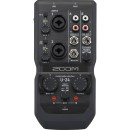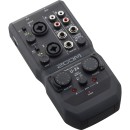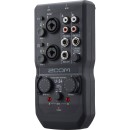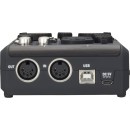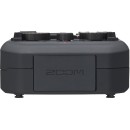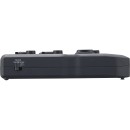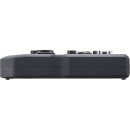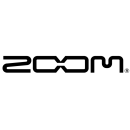Zoom U-24 Audio Interface Review
- Two-channel audio interface with high-quality recording and playback.
- Compatible with both Mac and Windows operating systems.
- Features combo inputs for XLR and TRS connections.
- Provides 48V phantom power for condenser microphones.
- Includes MIDI input and output for connecting external devices.
- Bus-powered via USB, no external power supply needed.
- Direct monitoring for zero-latency monitoring.
- Compact and portable design for easy transportation.
In-Depth Analysis of Zoom U-24 Specifications and Features
The Zoom U-24 Audio Interface is a compact and versatile audio interface designed to meet the needs of musicians, producers, and podcasters. It offers high-quality audio recording and playback with its two-channel input and output capabilities. The device is equipped with a pair of high-performance microphone preamps, ensuring clear and detailed sound capture. With its portable design, the U-24 is ideal for those who need a reliable audio interface on the go, providing professional-grade audio without the bulk of larger interfaces.
One of the standout features of the U-24 is its compatibility with various devices. It can be connected to both computers and iOS devices, making it a flexible choice for different recording environments. The interface supports resolutions up to 24-bit/96kHz, allowing users to record with pristine clarity. Additionally, it includes MIDI input and output ports, which enable seamless integration with MIDI-compatible devices, further expanding its utility for musicians and producers who work with digital instruments.
The Zoom U-24 is designed with user convenience in mind, featuring a simple layout with intuitive controls. It operates on bus power when connected to a computer, eliminating the need for an external power supply. For added versatility, it can also run on two AA batteries, making it perfect for mobile recording sessions. The U-24's robust build and high-quality audio performance make it a popular choice for those seeking a reliable, portable, and feature-rich audio interface.
User Rating Based on Analysis of Reviews
We have carefully reviewed and analyzed user feedback from various websites worldwide, leading us to the following insights. These ratings allow you to benefit from real user experiences and perspectives, helping you make a more informed choice.
Purchase Value
85% of users found the Zoom U-24 Audio Interface to be a great value for money. They appreciated the product's competitive pricing, which provides a decent set of features comparable to more expensive models. Users highlighted the dual XLR/TRS combo inputs and the quality of preamps as standout features, making it an excellent option for budget-conscious musicians and podcasters.
15% of users felt that the Zoom U-24 did not offer good value for its price. These users pointed out the limited number of outputs and the lack of certain advanced features found in similarly priced interfaces. Some also mentioned that they needed to spend extra on additional accessories to fully utilize the device, which detracted from its overall value.
Quality of Materials
78% of users were satisfied with the quality of materials used in the Zoom U-24, citing its sturdy build and reliable construction. They noted that despite being made largely of plastic, the interface felt robust and was able to withstand regular use without showing signs of wear quickly. The compact design was also praised for its portability and ease of use in different environments.
22% of users were not satisfied with the materials used in the Zoom U-24. They reported that the plastic casing felt somewhat cheap and expressed concerns about its durability over time. Some users also mentioned issues with knobs and switches feeling loose or flimsy, which led to doubts about the product's longevity.
Sound Quality
90% of users were highly satisfied with the sound quality provided by the Zoom U-24. They praised the clarity and depth of the audio, noting that the preamps delivered clean sound with minimal noise. Users found the interface to be well-suited for both home recording and live performances, offering excellent fidelity for its price range.
10% of users expressed dissatisfaction with the sound quality, mentioning occasional issues with noise interference and a lack of warmth compared to higher-end models. Some users felt that the interface struggled with more complex audio setups, leading to distortion or a loss of audio detail in certain scenarios.
Ease of Use
88% of users found the Zoom U-24 easy to use, praising its straightforward setup process and intuitive controls. Users appreciated the clear labeling of inputs and outputs, which made it simple to connect their devices and start recording. The bundled software and compatibility with various DAWs also contributed to the positive user experience.
12% of users encountered difficulties with the ease of use, primarily due to driver installation issues and lack of comprehensive documentation. Some users reported confusion with the software interface and struggled to optimize settings for their specific needs. These challenges led to frustration, particularly among less tech-savvy individuals.
Portability
92% of users praised the portability of the Zoom U-24, highlighting its compact size and lightweight design. Musicians and podcasters appreciated the ability to easily transport the interface for on-the-go recordings, with many users mentioning that it fits conveniently into a small bag or backpack.
8% of users were less satisfied with the portability, citing the need for additional cables and power sources as a drawback. Some users also mentioned that while the device itself is compact, the lack of a built-in power supply can be inconvenient for truly mobile setups.
Durability
80% of users were satisfied with the durability of the Zoom U-24, noting that it held up well under regular use. Many users felt confident in the interface's ability to withstand minor bumps and travel-related stress without significant damage.
20% of users expressed concerns regarding the durability of the Zoom U-24. They reported issues such as loose connectors and buttons after extended use, as well as occasional problems with the USB connection becoming unstable over time.
Connectivity Options
82% of users were satisfied with the connectivity options available on the Zoom U-24, appreciating the dual XLR/TRS combo inputs and MIDI I/O. These features provided flexibility for connecting a variety of instruments and equipment, making the interface versatile for different recording needs.
18% of users were dissatisfied with the connectivity options, noting limitations such as the lack of multiple output channels and digital inputs. Some users found the absence of an optical output and limited headphone outputs to be restrictive for more complex audio setups.
Driver Stability
76% of users were satisfied with the stability of drivers for the Zoom U-24, noting that once installed, the drivers performed reliably across different operating systems. Users appreciated the consistent updates provided by Zoom to address any software compatibility issues.
24% of users faced challenges with driver stability, experiencing issues such as crashes or unrecognized devices on certain systems. Some users found the installation process cumbersome and noted that driver updates sometimes lagged behind operating system updates, causing temporary disruptions.
Latency
84% of users were satisfied with the low latency performance of the Zoom U-24, noting that it delivered real-time audio monitoring without noticeable delay. This feature was particularly appreciated by musicians and producers who require precise timing during recording sessions.
16% of users experienced latency issues, particularly when using the interface with complex DAW setups or older computers. These users noted that despite adjusting buffer settings, they occasionally encountered lag that affected their recording and mixing process.
Compatibility
86% of users were satisfied with the Zoom U-24's compatibility with various operating systems and DAWs. They appreciated that the interface worked seamlessly with both Mac and Windows platforms, enhancing its versatility for different users.
14% of users faced compatibility issues, particularly with certain Linux distributions and older software versions. Some users expressed frustration with occasional glitches and the need for workarounds to achieve full functionality on less common systems.
Customer Support
75% of users were satisfied with the customer support provided by Zoom, citing prompt responses and helpful solutions to technical inquiries. Users appreciated the availability of online resources and forums that offered additional support.
25% of users were dissatisfied with the customer support, mentioning long wait times and inadequate responses to complex issues. Some users felt that the support team lacked detailed knowledge about the product, leading to unsatisfactory resolutions.
Aesthetics
83% of users liked the aesthetics of the Zoom U-24, praising its sleek and professional design. The compact form factor and clean, modern appearance were noted as appealing features that complemented their home studio setups.
17% of users were less impressed with the aesthetics, describing the design as basic and lacking flair. Some users felt that the interface's look did not match the quality of its performance, suggesting that a more premium finish would enhance its appeal.
Bundled Software
80% of users appreciated the bundled software with the Zoom U-24, finding it useful for getting started with recording and production. Users valued the inclusion of basic DAW and effects plugins, which added to the overall package's appeal.
20% of users were dissatisfied with the bundled software, citing limitations in functionality and compatibility with other programs. Some users felt that the software included was too basic for more advanced production needs, requiring them to purchase additional software.
Feature Set
88% of users were satisfied with the feature set of the Zoom U-24, highlighting its comprehensive range of inputs, MIDI functionality, and USB bus power option. Users found these features sufficient for most recording and live performance scenarios, enhancing the interface's versatility.
12% of users found the feature set lacking, particularly due to the absence of certain advanced functions such as multi-track recording capabilities and additional output options. These users felt that the interface was more suited to basic setups and could not cater to complex audio requirements.
Preamps
89% of users were impressed with the quality of the preamps in the Zoom U-24, noting their ability to deliver clean, noise-free sound. Users appreciated the headroom and clarity provided by the preamps, which were suitable for both dynamic and condenser microphones.
11% of users expressed dissatisfaction with the preamps, mentioning occasional issues with noise and a lack of power when using certain types of microphones. Some users felt that while the preamps were adequate, they did not match the quality of those found in more premium audio interfaces.
Input Flexibility
85% of users were pleased with the input flexibility of the Zoom U-24, appreciating the ability to connect a variety of instruments and microphones. The dual XLR/TRS combo inputs were particularly praised for accommodating different recording setups.
15% of users felt that input flexibility was lacking, particularly due to the limited number of inputs available for simultaneous recording. Some users found this restrictive for larger projects that required multiple audio sources.
Output Options
78% of users were satisfied with the basic output options on the Zoom U-24, appreciating the inclusion of both headphone and line outputs. These options were sufficient for home studio setups and small live performances.
22% of users were dissatisfied with the output options, citing limitations in the number and type of outputs available. Some users desired additional outputs for routing audio to multiple devices simultaneously, which the interface did not support.
MIDI Functionality
87% of users were satisfied with the MIDI functionality of the Zoom U-24, finding it easy to integrate with their existing MIDI equipment. Users appreciated the seamless connection and reliable performance during recording sessions.
13% of users encountered issues with MIDI functionality, reporting connectivity problems and occasional lag. Some users found the MIDI implementation to be basic, lacking advanced features required for intricate MIDI setups.
Overall Performance
90% of users were highly satisfied with the overall performance of the Zoom U-24, noting its reliability and consistent delivery of high-quality audio. Users commended its ability to handle various recording tasks with ease, making it a dependable choice for both beginners and experienced users.
10% of users experienced performance issues, such as occasional dropouts and audio glitches. These problems were often attributed to software conflicts or hardware limitations, leading to frustration and impacting their overall satisfaction.
User Manual
74% of users found the user manual for the Zoom U-24 helpful, providing clear instructions and useful tips for setup and operation. Users appreciated the inclusion of troubleshooting sections that assisted in resolving common issues.
26% of users were dissatisfied with the user manual, describing it as lacking depth and detail. Some users felt that the manual did not cover advanced features or provide sufficient guidance for complex setups, requiring them to seek additional resources online.
In the following sections, we will present a thorough review of the Zoom U-24 Audio Interface's specifications, highlighting its key features, as well as its advantages and disadvantages. This comprehensive analysis will help you understand the capabilities and limitations of this product.
Pros:
- Compact and portable design, making it easy to transport.
- High-quality preamps for clear audio recording.
- Dual inputs with XLR/TRS combo jacks support a variety of instruments and microphones.
- Provides phantom power for condenser microphones.
- Direct monitoring feature with zero latency.
- Powered via USB or batteries, offering flexibility for different recording situations.
- Compatible with PC, Mac, and iOS devices.
Cons:
- Limited to only two input channels, which might not be sufficient for larger setups.
- Lacks MIDI connectivity, limiting its use with MIDI devices.
- Basic software bundle compared to some competitors.
- Plastic construction may not be as durable as metal alternatives.
- No digital output options like S/PDIF.
General
| Channels of I/O | Analog: 2 Inputs / 4 Outputs |
|---|---|
| Built-In DSP | |
| Maximum Sampling Rate | 96 kHz / 24-Bit |
| Number of Microphone Inputs | 2 Preamps |
| Built-In Microphone | |
| Input Level Adjustment | 2x Knob |
| Expansion Slots |
Channels of I/O: The Zoom U-24 features 2 analog inputs and 4 outputs. This configuration allows for versatile audio routing and monitoring capabilities. With two inputs, users can connect microphones or instruments, while the four outputs enable flexible connections to speakers or other devices, making it suitable for both recording and live performance scenarios.Show More
Built-In DSP: The U-24 does not include built-in digital signal processing (DSP). This means that users will not have access to onboard effects or sound manipulation tools. Instead, users can utilize external software or hardware for processing, offering greater flexibility for those who prefer a specific workflow or want to use particular plugins.
Maximum Sampling Rate: The maximum sampling rate of 96 kHz at 24-bit provides high-resolution audio recording. This quality ensures that the sound captured is detailed and clear, making it ideal for professional audio applications. Higher sampling rates can lead to better sound fidelity and allow for more nuanced audio editing.
Number of Microphone Inputs: With 2 microphone preamps, the U-24 can accommodate two microphones simultaneously. This is beneficial for recording duets, interviews, or multi-mic setups for instruments. The quality of the preamps can significantly affect the overall sound, and having two allows for more complex recording arrangements.
Built-In Microphone: The U-24 does not come with a built-in microphone. This design choice emphasizes the use of external microphones, which can be chosen based on individual preferences or recording needs. Users can select high-quality mics tailored to their specific applications, ensuring optimal sound capture.
Input Level Adjustment: The device features a 2x knob for input level adjustments, allowing users to easily control the gain for each input. This feature is crucial for achieving the correct audio levels, preventing distortion or clipping during recording. Having physical knobs provides a tactile and intuitive way to manage levels on the fly.
Expansion Slots: There are no expansion slots available on the U-24, meaning that the device has a fixed set of features and capabilities. While this may limit future upgrades or additions, it also simplifies the design and usability for those who need a straightforward audio interface without the complexity of additional modules.
Signal Processing
| Pad | |
|---|---|
| Gain/Trim Range | Inputs: 0 to 43 dB |
| High-Pass Filter | |
| Solo/Mute | Mute per Master |
Pad: The absence of a pad feature in the Zoom U-24 means that it does not have a built-in attenuator to reduce the level of the incoming signal. This can be important for recording loud sources, as a pad can help prevent distortion by lowering the signal level before it reaches the preamp. Users will need to manage loud inputs carefully to avoid clipping during recording.Show More
Gain/Trim Range: The gain/trim range for the inputs spans from 0 to 43 dB. This range indicates the amount of amplification that can be applied to the incoming audio signal. A higher dB value allows for capturing quieter sounds more effectively, while lower settings are suitable for louder sources. This flexibility is essential for achieving optimal recording levels and ensuring clear audio quality across various input types.
High-Pass Filter: The absence of a high-pass filter means that the Zoom U-24 does not have a built-in option to eliminate low-frequency sounds, which can sometimes muddy recordings. A high-pass filter is useful for reducing unwanted low-end noise from instruments or ambient sounds. Users may have to rely on external processing or careful mic placement to manage low-frequency interference in their recordings.
Solo/Mute: The Zoom U-24 features a mute option per master, allowing users to silence the overall output temporarily. This can be useful during recording sessions when a quick silence is needed without affecting the channels individually. However, the lack of a solo function means that isolating specific tracks for monitoring purposes is not available directly through the interface, which may require alternative methods for track management during playback.
Connectivity
| Analog Audio I/O | 1x Combo XLR-1/4" TRS Balanced/Unbalanced Mic/Line/Hi-Z Input 1x Combo XLR-1/4" TRS Balanced/Unbalanced Mic/Line Input 2x 1/4" TRS Balanced Monitor Output 2x Stereo RCA Coaxial Unbalanced Line Output 1x 1/4" TRS Unbalanced Headphone Output |
|---|---|
| Phantom Power | 48 V, Selectable On/Off (Applied to All Inputs) |
| Digital Audio I/O | |
| Host Connection | 1x USB-B (Class-Compliant) |
| Host Connection Protocol | USB 2.0 |
| USB (Non-Host) | 1x Micro-USB (Power Input) |
| Sync I/O | |
| Network I/O | |
| MIDI I/O | 1x DIN 5-Pin Input 1x DIN 5-Pin Output |
| Wireless |
The Analog Audio I/O section outlines the various input and output options available on the Zoom U-24 Audio Interface. It includes two combo XLR-1/4" TRS inputs, which can accommodate microphones, line-level signals, or high-impedance instruments, providing versatility for different audio sources. The device also features balanced monitor outputs and unbalanced line outputs, ensuring clear sound reproduction. Additionally, a headphone output allows for easy monitoring of audio signals, making it suitable for both studio and live applications.Show More
With regards to Phantom Power, the Zoom U-24 provides 48V of phantom power that can be toggled on or off for all inputs. This feature is essential for powering condenser microphones, which require this external voltage to operate. The ability to selectively activate phantom power enhances the interface's flexibility, allowing users to connect a variety of microphones without needing additional equipment.
The Digital Audio I/O specification indicates that the device does not support digital audio input or output. Instead, it relies solely on analog connections, which is typical for many compact audio interfaces aimed at straightforward recording and playback tasks.
In terms of Host Connection, the U-24 utilizes a USB-B connection that is class-compliant, meaning it can work seamlessly with most operating systems without the need for additional drivers. This is complemented by a Micro-USB power input, ensuring that the device can be powered via standard USB connections, which adds convenience for mobile setups.
The MIDI I/O feature includes both a DIN 5-Pin input and output, allowing users to connect and control MIDI devices. This is particularly useful for musicians and producers who want to integrate MIDI controllers or synthesizers into their workflow. However, it's worth noting that the device does not provide sync or network I/O options, which limits its connectivity for more complex setups.
Lastly, the absence of Wireless functionality means that the Zoom U-24 is designed for wired connections only, reinforcing its focus on reliability and simplicity in audio recording and playback. This can be advantageous for users who prioritize stable connections over the convenience of wireless technology.
Performance
| Frequency Response | System: 20 Hz to 20 kHz +0/-1 dB (at 44.1 kHz) 20 Hz to 40 kHz +0/-3.5 dB (at 96 kHz) |
|---|---|
| Maximum Input Level | Line Inputs: +20.7 dBu Mic Inputs: +2.7 dBu |
| Maximum Output Level | Monitor Outputs: +10 dBu at 0 dBFS Line Outputs: +8 dBu at 0 dBFS Headphone Outputs: +10 dBu at 0 dBFS |
| Headphone Output Power | 30 mW per Channel into 32 Ohms |
| Impedance | Combo XLR-1/4" Mic Inputs: 2.6 Kilohms Combo XLR-1/4" Hi-Z Inputs: 1.1 Megohms Monitor Outputs: 1 Kilohm Line Outputs: 330 Ohms Headphone Outputs: 33 Ohms |
| EIN | Inputs: -119.5 dBA (150-Ohm Source) |
The Frequency Response specification indicates the range of frequencies the audio interface can accurately reproduce. For the Zoom U-24, it covers the standard human hearing range from 20 Hz to 20 kHz with minimal deviation at 44.1 kHz sample rate, ensuring clarity in sound reproduction for most audio applications. At a higher sample rate of 96 kHz, it extends to 40 kHz, allowing for better quality in recording high-frequency sounds, which can be crucial for certain instruments and audio effects.Show More
Maximum Input Level refers to the highest signal level the device can handle before distortion occurs. For line inputs, a maximum level of +20.7 dBu allows for professional-grade audio sources without clipping, while the +2.7 dBu for mic inputs indicates sensitivity to lower-level signals, making it suitable for various microphones. This flexibility permits users to connect a range of audio sources while maintaining sound integrity.
The Maximum Output Level specifies the peak output levels available for monitor, line, and headphone outputs. With +10 dBu for monitor and headphone outputs, and +8 dBu for line outputs, the U-24 is capable of driving studio monitors and headphones effectively, ensuring that audio playback is loud and clear without distortion. This level of output is particularly important during mixing and monitoring phases of audio production.
Headphone Output Power indicates the power delivered to headphones, measured at 30 mW per channel into 32 Ohms. This power rating ensures that the headphones can produce adequate volume levels, allowing users to hear details clearly during recording and mixing sessions. Adequate power is crucial for professional audio work, as it allows for accurate monitoring of audio quality.
The Impedance specifications reflect the resistance levels of different inputs and outputs. The combo XLR-1/4" mic inputs with an impedance of 2.6 Kilohms make them compatible with a wide range of microphones, while the Hi-Z inputs' 1.1 Megohms impedance is ideal for high-impedance instruments like electric guitars. Lower impedance in outputs like headphone (33 Ohms) and line outputs (330 Ohms) helps in maintaining a strong signal and compatibility with various devices.
Finally, the EIN (Equivalent Input Noise) rating of -119.5 dBA indicates the noise level present at the inputs with a standard 150-Ohm source. This low noise level is essential for professional audio interfaces, as it ensures that the recorded sound is clean and free from unwanted background noise, leading to a higher quality audio production overall.
Digital Audio
| Sample Rates | 44.1 / 48 / 88.2 / 96 kHz |
|---|---|
| Sample Rate Conversion | |
| Bit Depths | 24-Bit |
| Latency | Zero-Latency Direct Monitoring |
| Sync Sources | Internal |
Sample Rates refer to the number of samples of audio carried per second, measured in kilohertz (kHz). The Zoom U-24 Audio Interface supports multiple sample rates, including 44.1 kHz, 48 kHz, 88.2 kHz, and 96 kHz. Higher sample rates can capture more detail and provide better audio quality, making them ideal for professional recordings and high-fidelity applications. Choosing the right sample rate can significantly affect the clarity and richness of audio playback and recording.Show More
Sample Rate Conversion indicates whether the audio interface can convert audio between different sample rates. The U-24 does not feature sample rate conversion, meaning that it will operate at the selected sample rate without automatically adjusting to match other devices' settings. This simplicity can be advantageous for users who prefer a straightforward setup, but it may require careful management of sample rates when integrating with other equipment.
Bit Depths define the number of bits used to represent each audio sample. The U-24 supports a 24-bit depth, which allows for a wider dynamic range and more detailed audio representation compared to lower bit depths. This feature is crucial for capturing nuanced sounds and providing a more professional sound quality, especially during mixing and mastering processes.
Latency refers to the delay between input and output in an audio system. The U-24 provides Zero-Latency Direct Monitoring, which means that users can listen to their input signal in real-time without any noticeable delay. This feature is particularly beneficial for musicians and vocalists during recording sessions, as it allows them to hear themselves clearly without distractions caused by latency.
Sync Sources are the methods used to synchronize audio playback and recording. The U-24 operates with an Internal sync source, meaning it maintains its timing based on its internal clock. This ensures consistent audio performance and is typically sufficient for most recording tasks. However, users should ensure that their setup is compatible with this sync method to avoid potential timing issues during complex projects.
Audio Storage & Playback
| Memory Card Slot |
|---|
Memory Card Slot: The absence of a memory card slot in the Zoom U-24 Audio Interface means that users cannot directly record audio onto external storage devices like SD cards. This feature is often found in portable recorders to allow for easy expansion of storage. Instead, the U-24 relies on a connection to a computer for audio recording, which can be beneficial for those who prefer working in a digital audio workstation (DAW) environment. However, it may limit portability for users who might want to record independently from a computer.
Compatibility
| OS Compatibility | macOS 10.9.5 or Later Windows 7 or Later (32-/64-Bit) 7.1 or Later |
|---|---|
| Included Plug-Ins | |
| Processor Requirement | Intel Core i3 |
| Mobile App Compatible | Yes: iOS Only App Name: Cubase LE Functionality: Access Stored Files, Adjust Settings |
| Mobile Device Compatibility | iPhone iPad |
| Required Hardware | Available USB 2.0 Port or USB 3.0 / 3.1/3.2 Gen 1 Port USB Cable (Included) |
| Internet Connection | Required for Registration, Software/Driver Download |
The OS Compatibility specification indicates the operating systems that the Zoom U-24 Audio Interface can work with. It is compatible with macOS versions 10.9.5 and later, as well as Windows 7 and later for both 32-bit and 64-bit systems. This ensures that users can utilize the device across a wide range of modern computers, making it versatile for different environments and setups.Show More
Under the Included Plug-Ins section, it states that no additional plug-ins are included with the device. This means users will need to source any necessary software enhancements or effects from third-party developers or other platforms, giving them the flexibility to customize their audio experience, but also requiring additional effort to find suitable options.
The Processor Requirement specifies that the Zoom U-24 requires at least an Intel Core i3 processor to operate effectively. This ensures that the device can handle audio processing tasks without lag, providing a smooth recording and playback experience for users, especially when working with multiple tracks or effects.
In terms of Mobile App Compatibility, the device is compatible with iOS devices through the app called Cubase LE. This feature allows users to access stored files and adjust settings directly from their mobile devices, enhancing the portability and convenience of using the audio interface in various settings.
The Required Hardware section notes that an available USB 2.0 or USB 3.0/3.1/3.2 Gen 1 port is necessary to connect the device, along with a USB cable provided in the package. This ensures straightforward connectivity with most modern computers and devices, allowing users to set up quickly without needing additional equipment.
Finally, the Internet Connection requirement indicates that users will need an internet connection for registration and to download necessary software or drivers. This is essential for keeping the device updated and for accessing any additional features that may enhance its functionality.
Power
| Power Requirements | AC/DC Power Adapter (Not Included), Battery, or USB Bus Power |
|---|---|
| AC/DC Power Adapter | 5 VDC (Not Included) |
| Power Consumption | 5 W (Maximum) |
| Battery Type | 2x AA |
| Approximate Battery Life | 4 Hours (Phantom Off) |
The Power Requirements section of the Zoom U-24 Audio Interface specifies the various ways the device can be powered. Users have the flexibility to choose between an AC/DC power adapter, batteries, or USB bus power. This versatility allows for use in different environments, whether in a studio setting, on stage, or while traveling. The inclusion of multiple power options ensures that users can always find a suitable power source for their needs.Show More
The AC/DC Power Adapter requirement indicates that the device needs a specific voltage to function optimally, which is noted as 5 VDC. However, it is important to note that the power adapter is not included with the device, so users will need to acquire it separately. This specification ensures that the interface operates efficiently without any interruptions during use.
Power Consumption refers to the maximum amount of power the device will draw, which is recorded at 5 W. Understanding power consumption is crucial for users to ensure that their power source can handle the load without causing any performance issues or potential damage to the device.
The Battery Type section specifies that the Zoom U-24 can operate using two AA batteries. This is particularly useful for mobile recording or live performances where access to power outlets may be limited. Moreover, the Approximate Battery Life of 4 hours (when phantom power is off) gives users an idea of how long they can expect to use the device on battery power alone, allowing for better planning during live events or recording sessions.
Physical
| Dimensions | 7.55 x 3.63 x 1.68" / 19.18 x 9.23 x 4.27 cm |
|---|---|
| Weight | 10.1 oz / 285.0 g |
The Dimensions of the Zoom U-24 Audio Interface indicate its physical size, measured in both inches and centimeters. With dimensions of 7.55 x 3.63 x 1.68 inches, this compact design allows for easy transportation and integration into various setups. Such a size is beneficial for musicians and sound engineers who need a portable solution for recording or processing audio while on the go.Show More
The Weight of the device is also a crucial consideration for portability. At 10.1 ounces (or 285 grams), the U-24 is lightweight enough to carry without significant burden, making it an ideal choice for traveling artists or those with limited workspace. A lightweight interface can enhance usability, allowing users to set up and relocate their audio equipment with ease.
Packaging Info
| Package Weight | 1.35 lb |
|---|---|
| Box Dimensions (LxWxH) | 9.291 x 6.772 x 2.284" |
Package Weight refers to the total weight of the Zoom U-24 Audio Interface when it is packaged for sale. At 1.35 lb, this lightweight design makes it easy to transport, whether for live performances or studio sessions. A lighter weight can be advantageous for musicians and audio engineers who may need to move equipment frequently.Show More
Box Dimensions (LxWxH) indicate the physical size of the packaging that contains the audio interface, measured in inches. The dimensions of 9.291 x 6.772 x 2.284" suggest that the Zoom U-24 is compact and designed for convenience. Smaller dimensions can allow for easier storage and portability, making it suitable for those who may have limited space or need to carry their equipment in a backpack or gig bag.
Customer Images
Customer Questions
How do I install the Zoom U-24 drivers on my computer?
To install the Zoom U-24 drivers, visit the official Zoom website, navigate to the 'Support' section, and download the latest driver for your operating system. Once downloaded, run the installer and follow the on-screen instructions to complete the installation.
Why is my Zoom U-24 not being recognized by my computer?
Ensure that the Zoom U-24 is powered on and properly connected to your computer via USB. Try using a different USB cable or port. Check if the drivers are installed correctly and update them if necessary. Restart your computer to see if it resolves the issue.
What should I do if there is no sound output from my Zoom U-24?
Make sure that the output device in your computer's sound settings is set to the Zoom U-24. Check the volume levels on both your computer and the interface. Ensure that the correct output channels are selected on the interface and that your speakers or headphones are properly connected.
How can I reduce latency when using the Zoom U-24?
To reduce latency, ensure you are using the latest drivers for the Zoom U-24. Adjust the buffer size in your DAW's audio settings to a lower value. Also, close any unnecessary applications that may be consuming CPU resources.
Why is there a buzzing noise when I connect my Zoom U-24?
A buzzing noise can result from a ground loop issue. Try using balanced cables for your audio connections. Ensure that all connected devices share the same power source or use a ground loop isolator. Check for any loose connections and ensure cables are not damaged.
How do I connect microphones to the Zoom U-24?
Connect your microphone to one of the combo inputs on the front panel of the Zoom U-24 using an XLR or 1/4-inch cable. If your microphone requires phantom power, press the 'PHANTOM' button on the interface.
What should I do if the Zoom U-24's LED lights are not turning on?
Ensure that the Zoom U-24 is properly connected to a power source or your computer via USB. If using USB power, try a different USB port or cable. If the problem persists, check for any hardware issues or contact Zoom support.
Can I use the Zoom U-24 with an iPad or iPhone?
Yes, the Zoom U-24 can be used with an iPad or iPhone. You will need a Lightning to USB Camera Adapter to connect the interface to your device. Ensure that the interface is powered using batteries or an external power source.
How do I update the firmware on my Zoom U-24?
Download the latest firmware update from the Zoom website. Connect the U-24 to your computer via USB, then run the firmware updater application. Follow the on-screen instructions to complete the firmware update.
Why is my recording level too low with the Zoom U-24?
Ensure the gain knobs on the U-24 are turned up to an appropriate level. Check that your DAW or recording software's input levels are set correctly. Verify that your microphone or instrument is properly connected and functioning. If using a microphone, ensure phantom power is enabled if required.
